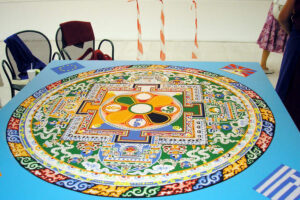Avalokiteshevara, or Chenrezig as he is known in Tibetan, is a Buddhist deity who personifies the ideal of compassion. He can be portrayed in several different forms, two of the most popular being as a white deity with four arms or one thousand arms. The extra arms symbolise his ability to help many beings simultaneously.
The mandala can be described as being the residence of the respective deities and their retinues. The sand mandala of Avalokiteshvara was originated from the tantric teachings of Lord Buddha Shakyamuni. Although depicted on a flat surface, the mandala is actually three-dimensional, being a “divine mansion” at the centre of which resides Avalokiteshvara, surrounded by the deities of his entourage.
Every aspect of the Mandala has meaning: nothing is arbitrary or superfluous. The four outer walls of the mansion are in five transparent layers, coloured in white, yellow,
red, green and blue. These represent faith, effort, memory, meditation and wisdom, as well as the five dankinis. The four doorways, one in the centre of each of the four walls, represent the four immeasurable thoughts: love, compassion, joy, and equanimity, and these are decorated with precious jewels. The lotus flowers in the centre of the mandala represent the lotus family, one of the Buddha families that corresponds to the five psycho-physical components of a human being, which purify specific impure states of mind; the lotus families purify passion into discriminating awareness.
The white thousand-armed, thousand-eyed Avalokiteshvara stands in the centre of the lotus flower, on a white moon disk. In the four directions are his retinue, seated on white full moon disks. The deities arise from the unity of the wisdom of emptiness and great bliss of the principal deity, Avalokiteshvara.
In the East, seated on a red petal, is the purified aspect of Hatred in the form of a blue Akshobhya; in the South, seated on a yellow petal, is the purified aspect of Misery in the form of a yellow deity Rathasambhava; and likewise, the purified part of ignorance and jealousy are represented by the white deity Vaivochana at the west and the green deity Amogasiddhi on the northern petal respectively.
The central deity Avalokiteshvara represents freedom from attachment. The four colours in the four directions are the emanated light rays of the four deity retinues. The lotus itself symbolizes the mind of renunciation. To protect the residence from negative conditions, it is surrounded by a Vajra fence, which also symbolizes the continuous teaching of the Vajrayana (Tantra Teaching) by the principal deity Avalokiteshvara. In the outmost part, it is circled with burning flames radiating intense light, which is not only for protection but also to get rid of delusion and the darknesses of ignorance.
In general, the mandala shows a method of bringing peace and harmony to our world, through genuine practice of the mind of Great Compassion, the wisdom of Emptiness, and the meditations of the mandala with their respective deities. We can generate the respective qualities as mentioned and thereby bring about positive changes in this world of ours. For a practitioner who meditates on the Tantra of Avalokiteshvara, one would familiarize oneself with every detail of the Mandala and the deities within it, engaging in repeated exercises based upon visualizing beings and pure environment which symbolize one’s own being and environment in a purified, sublime form. Such exercises carried out within the basic Buddhist framework of developing wisdom and compassion, bring about a profound transformation of the psyche.
Just to glimpse the Mandala, however, will create a positive impression on the mind-stream of the observer, who for a moment is in touch with the profound potential for perfect Enlightenment, which exists within the mind of all beings.
At the end of the ritual ceremony, the Mandala will be systematically dismantled, and the sand of the Mandala will be thrown into a clean river or a sea as a reminder of the impermanence of the world by performing Naga Rituals. In fact, it serves to enrich the soil and the mineral resources, and to eliminate the untimely death, diseases, famine and other disasters.

